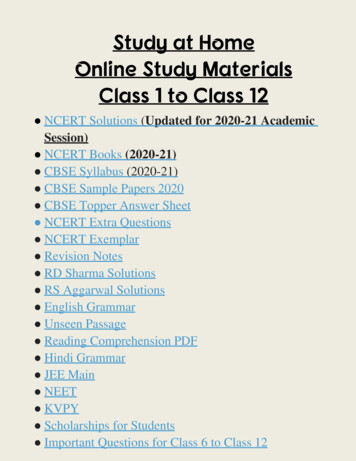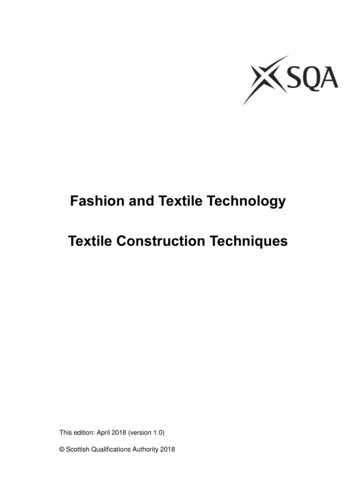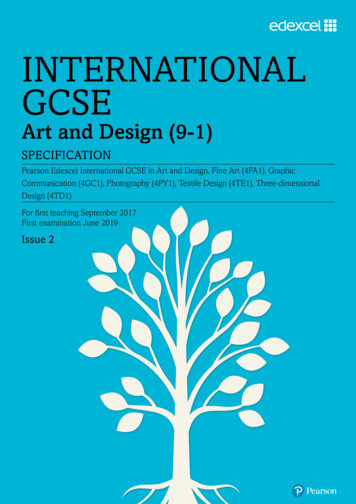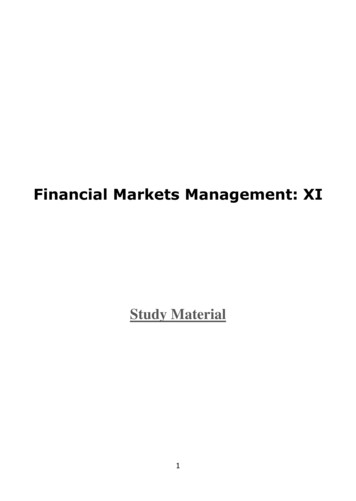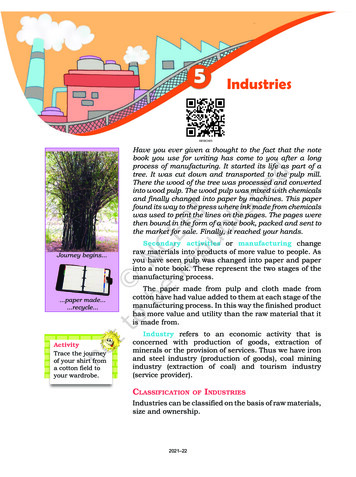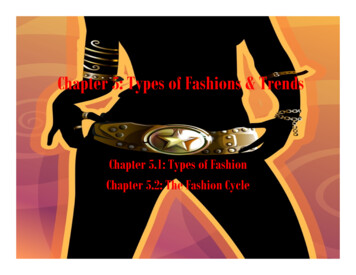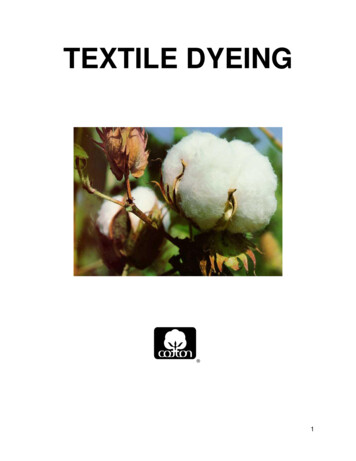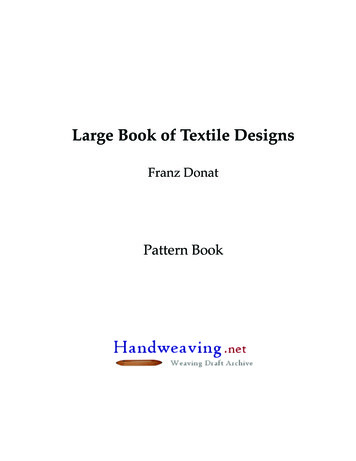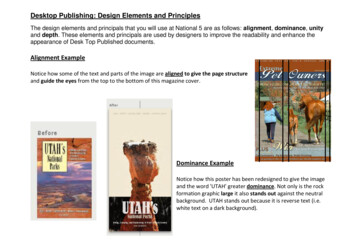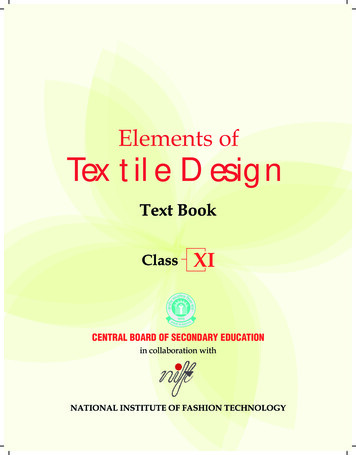
Transcription
Elements ofTextile DesignText BookClassXICENTRAL BOARD OF SECONDARY EDUCATIONin collaboration withNATIONAL INSTITUTE OF FASHION TECHNOLOGY
Elements of TEXTILE DESIGNTextile Science Text Book Class XIPrice: 285/First Edition 2013, CBSE, IndiaReprinted : July, 2017Copies: 500"This book or part thereof may not be reproduced byany person or agency in any manner."Published By:The Secretary, Central Board of Secondary Education,Shiksha Kendra, 2, Community Centre, Preet Vihar,Delhi-110092Design & Layout:Multi Graphics, 8A/101, WEA Karol Bagh, New Delhi-110005Phone: 011-25783846Printed By:Raj Printers, A-9, Sector B-2, Tronica City, Loni (Gzb.)
Eiw.kZ ¹izHkqRo&laiUulektoknhiaFkfujis{kyksdra kkRedx.kjkT;ºcukusdsfy,]rFkkmldsleLrukxfjdksa r]fo'okl]/eZvkSjmiklukdhLora a prdjusokyhca/qrkc kusdsfy,n ladYigksdjviuhbllafo/kulHkkesa vktrkjh[k26uoEcj]1949bZñdks,rn gSaA1- 311977)ls¶izHkqRo&laiUuyksdra kkRedx.kjkT; dsLFkkuijizfrLFkkfirA2- 311977)ls¶jk"Vªdh,drk kSjjk"Vªxkudkvknjdjs([k)Lora kn'kksZa dksân;esa svkSjvkg okufd,tkusijjk"Vªdhlsokdjs(Ä)HkkjrdslHkhyksxksa esa lejlrkvkSjlekuHkzkr ijvk/kfjrlHkhHksnHkkolsijsgksa],slhizFkkvksa dkR;kxdjstksfL k;ksa hijaijkdkegÙole svkSjmldk(N)izkÑfrdi;kZoj.kdhftldsvarxZrou] zkf.kek kdsizfrn;kHkkoj[ks(t)oSKkfudn ldjs( )lkoZtfudlaifÙkdkslqjf{krj[ksvkSjfgalklsnwjjgs( k)O;fDrxrvkSjlkewfgdxfrfof/;ksa dslHkh{ks kksa esa mRd"kZdhvksjc usdklrriz;kldjsftllsjk"Vªfujarjc rsgq,iz;RuvkSjmiyfC/dhubZmapkb;ksa u;e]2002dh/kjk4}kjk(12122002)lsa var%LFkkfirA
THE CONSTITUTION OF INDIAPREAMBLEWE, THE PEOPLE OF INDIA, having solemnly resolved to constitute India into a 1[SOVEREIGNSOCIALIST SECULAR DEMOCRATIC REPUBLIC] and to secure to all its citizens :JUSTICE, social, economic and political;LIBERTY of thought, expression, belief, faith and worship;EQUALITY of status and of opportunity; and to promote among them allFRATERNITY assuring the dignity of the individual and the2 [unity and integrity of the Nation];IN OUR CONSTITUENT ASSEMBLY this twenty-sixth day of November, 1949, do HEREBY ADOPT,ENACT AND GIVE TO OURSELVES THIS CONSTITUTION.1.Subs, by the Constitution (Forty-Second Amendment) Act. 1976, sec. 2, for "Sovereign Democratic Republic” (w.e.f. 3.1.1977)2.Subs, by the Constitution (Forty-Second Amendment) Act. 1976, sec. 2, for "unity of the Nation” (w.e.f. 3.1.1977)THE CONSTITUTION OF INDIAChapter IV AFUNDAMENTAL DUTIESARTICLE 51AFundamental Duties - It shall be the duty of every citizen of India(a)to abide by the Constitution and respect its ideals and institutions, the National Flag and the NationalAnthem;(b)to cherish and follow the noble ideals which inspired our national struggle for freedom;(c)to uphold and protect the sovereignty, unity and integrity of India;(d)to defend the country and render national service when called upon to do so;(e)to promote harmony and the spirit of common brotherhood amongst all the people of India transcendingreligious, linguistic and regional or sectional diversities; to renounce practices derogatory to the dignity ofwomen;(f)to value and preserve the rich heritage of our composite culture;(g)to protect and improve the natural environment including forests, lakes, rivers, wild life and to havecompassion for living creatures;(h)to develop the scientific temper, humanism and the spirit of inquiry and reform;(i)to safeguard public property and to abjure violence;(j)to strive towards excellence in all spheres of individual and collective activity so that the nation constantlyrises to higher levels of endeavour and achievement;1(k) who is a parent or guardian to provide opportunities for education to his/her child or, as the case may be,ward between age of six and forteen years.1.Ins. by the constitution (Eighty - Sixth Amendment) Act, 2002 S.4 (w.e.f. 12.12.2002)
Elements of TEXTILE DESIGNElements of Textile Design(CBSE Textbook for Class XI)PreambleTextile design involves a complete vision of development of new design aspects for novelty in fabricsurface, textile products and various other textile materials. It includes designing of fabric used inclothing, house hold textiles, decorative textiles and others. It involves design intervention alongwith the development of the final product within the technical specification and right commercialvalue.In order to create innovative surfaces and structures, "Elements of design" course is introduced asan elementary course. The course will provide an overview of Textile Design, Designer and TextileIndustry. The overall objective of this course is to understand the basics of design in relation withtextiles, textile design and related terminology and the overall work pattern of textile industry.CBSEMr. Vineet Joshi, IAS, Chairman, CBSEDr. Biswajit Saha (Associate Professor and Programme Officer), Vocational CellMs. Swati Gupta (Assistant Professor and Assistant Programme Officer), Vocational CellNIFTMr. Prem Kumar Gera, IASSr. Prof Banhi Jha, Dean (A)Prof. Kripal Mathur, RegistrarAnchorMs. Savita Sheoran Rana, Chairperson, Textile Design DepartmentContributorsProf. Anupam Jain, Professor at Textile Design Department, NIFT HyderabadMs. Kislaya Choudhary, Assistant Professor, Textile Design Department, NIFT Bhopal
Elements of TEXTILE DESIGNForewardThe Indian Textiles Industry has an overwhelming presence in the economic life of the countryand is one of the leading textile industries in the world. India earns about 27% of its total foreignexchange through textile exports. Further, the textile industry of India also contributes nearly 14%of the total industrial production of the country. It also contributes around 3% to the GDP of thecountry. India textile industry is also the second largest provider of employment in the country interms of after agriculture.As per the 12th Five year plan, the integrated skill development scheme aims to train over 2,675,000people within the next 5 years. This scheme would cover all sub sectors of the textile sector such astextiles and Apparel, handicraft, handlooms, jute and sericulture.In order to match the increasing requirement of skilled personnel, CBSE has initiated to introduce"Textile Design" as a vocational course for Class XI and XII. The course aims to introduce studentsto Elements of Design, Fabric science, Woven textiles, Dyeing & Printing procedures andintroduction to our traditional textiles. This will help students to join the industry after Class XII orthey can pursue higher education in this field.The Faculty of the National Institute of Fashion Technology has developed the curriculum and thelearning Material. I place on record the Board's thankful acknowledgement of the services renderedby Shri P.K. Gera, Director General, NIFT, Sr. Prof Banhi Jha, Dean- Academics, Project In-chargeand Ms. Savita Sheoran Rana, Chairperson, Textile Design Department, Project Anchor - TextileDesign. The course is developed and prepared by faculty members from Textile Design Departmentacross NIFT centers. CBSE also acknowledges the contribution by Prof. Anupam Jain, Hyderabad,Ms. Kislay Choudhary, Assistant Prof. Bhopal; Ms. Shubhangi Yadav, Associate Prof, Gandhinagar,Mohammad Javed, Associate Prof., Mumbai; Shri. Arnab Sen, Assistant Prof, Bhopal, Mr. DebojyotiGanguly, Assistant Prof., Bhopal and Shri. Shivalingam.I would like to appreciate Dr. Biswajit Saha, Associate Professor and Programme Officer, VocationalEducation Cell, CBSE and Ms. Swati Gupta, Assistant Professor and Assistant Programme Officer,Vocational Education Cell, CBSE and other members of Vocational Education Cell, CBSE is alsodeeply appreciated.Comments and suggestions for further improving the curriculum are always welcomeVineet JoshiChairman, CBSE
Elements of TEXTILE DESIGNUNIT – IObjectives:To understand the historical background of textiles. To get an overview of the textile industry and related industries. To get familiar with various textile materials and processes. To gain knowledge about textile design as a field. To understand the textile design as a profession and the role of Textile designers in Textile and Fashion Industry.To understand the work structure, timing and planning in Textile industry. To develop knowledge of forecast and market trends, its importance and need in Textileindustry.Learning Outcome:After finishing the course students shall be ableTo understand the overview of Textile industry including history and current industryscenario.To learn about the terminology associated with textile design material, process etc. To understand the importance of market and trends and enhance observational skills. To understand the Textile industry functional aspects and roles and responsibilities of adesigner.Course Content:1.An Overview of Textiles, history and industrial background2.Textile designer role responsibilities3.Textile material and process4.Textile industry work structure, time and planning5.Importance of market trend and forecastTeaching Methodology:Class lectures and Practical demonstrations
Elements of TEXTILE DESIGNClass-room quiz Presentations and Discussions in class Review and Feedback on assignments Market visit, Survey and Field visits to relevant Textile Manufacturing unit, museums etc. Evaluation Criteria:Written theory test: knowledge and understanding. Discussion and quiz: understanding. UNIT – IIObjectives:The main objective of this unit is to develop an understanding of the primary components of textiledesign, and the related process. The basic of textile design knowledge is essential and useful forfurther application in various sectors of textile design.To develop an understanding for the components of textile design, and the related process. To introduce the students to the basic principle and elements of design To develop interesting compositions using forms and colour. To develop sensitivity among the students for better understanding of forms and itsapplication for creating visual images of great value.Learning Outcome:After finishing the course students shall be ableTo understand the application of design elements and principles for textile designing. To get familiar with the design process and to make design ideas using innovative material and techniques.To enable students to work on various design compositions. Course Content:1. Elements of design2. Principles of design
Elements of TEXTILE DESIGNTeaching Methodology:Class lectures and practical demonstrations. Class-room assignments to create designs for specific textile product. Display, presentations and discussions in class. Review and feedback on assignments. Market visit, survey. Visits to design houses (if possible). Special lectures and presentations by textile professionals. Evaluation Criteria:Written theory test: knowledge and understanding. Practical assignments: application and skills. Design assignments: innovation in design ideas, creativity and functionality. Display and presentation: neatness and visual impact. UNIT – IIIObjectives:The main objective of this unit is to develop an understanding of the components of textile designthrough a complete process for creation of textile design patterns, repeats, various layouts, use ofcolors, creation of color ways for generating variety and the inspiration of design.To develop an understanding for the components of textile design, and the related process. To enable the students to utilize the principals and elements of design in application of textile design development.To understand motif and form development creative process through various methods. To develop interesting compositions using forms and colour. To develop sensitivity among the students for a wholesome understanding of the textile design process.Developing sensitivity to take various inspirations for development of design.
Elements of TEXTILE DESIGNLearning Outcome:After finishing the course students shall be able To understand the application of design elements and principles for textile designing. To get familiar with the design process and to make design ideas using innovative material andtechniques. To enable students to work on various design compositions, repeats, layouts and color ways.Course Content:1. Elements of textile design such as motif development, repeats, layouts and color ways.2. Inspiration for design and design process.Teaching Methodology: Class lectures and practical demonstrations. Class-room assignments to create designs for specific textile product. Display, presentations and discussions in class. Review and feedback on assignments. Market visit, Survey and field visits to Textile stores. Visits to design houses (if possible). Special lectures and presentations by textile professionals.Evaluation Criteria: Written theory test: understanding. Practical assignments: application and skills. Design assignments: innovation in design ideas, creativity and functionality. Display and presentation: neatness and visual impact.UNIT – IVObjectives:The main objective of this unit is to get an overview of the various types of textiles available inindustry. It includes study of knits, woven, printed, embellished and resist textiles. This unit
Elements of TEXTILE DESIGNdiversifies textiles through explaining various techniques and technology in textiles. The aim is alsoto understand the professional aspects of the work standards and methods existing in textileindustry at present. To develop an understanding for the variety available in textiles. To enablethe students to gain the knowledge of various techniques and methods of creatingvarious types of textiles. To develop understanding of textile terminology. To developunderstanding of professional aspects of the work practices existing in textileindustry in current scenario. Developing textile technique skills through practical application. Developing communication skills and ability too use right terminology for an effective Designpresentation.Learning Outcome:After finishing the course students shall be able To understand the application of various techniques available in textile industry. To be able to differentiate among various textiles by looking at technique of making and designaspects. To enable students to realize professional aspects of the work standards in textile industry atpresent. To be able to make an effective design presentation.Course Content:1. Types of various available Textiles by techniques2. Presentation of Design and Professional PracticesTeaching Methodology: Class lectures and practical demonstrations. Class-room assignments to create designs for specific textile product using specific techniques. Display, presentations and discussions in class. Review and feedback on assignments.
Elements of TEXTILE DESIGNMarket visit, Survey and field visits to nearby Textile manufacturing units. Visits to design houses (if possible). Special lectures and presentations by textile professionals. Evaluation Criteria:Written theory test: understanding. Practical assignments: application and skills. Design assignments: innovation in design ideas, creativity and functionality. Display and presentation: neatness and visual impact.
Elements of TEXTILE DESIGNContentsForewordAcknowledgementUNIT – I: Introduction to Textile Industry1Chapter 1:An Overview of Textiles:21.1History of Textiles21.2The Textile Industry71.3Textile Material and Process101.4Textile Design and Designer14Chapter 2:Textile Design and Designer:192.1Textile Design192.2Role of Textile Designer192.3Timing and Planning in Textile Industry222.4Forecast and Market Trends242.5Introduction to Types of Textiles27UNIT – II: The Primary Components of Textile Design31Chapter 3:Design Elements and Principles323.1The Elements of Textile ce343.1.5Texture343.1.6Colour35Principles of ion383.2.4Emphasis393.2.5Contrast403.2.6Unity403.2
Elements of TEXTILE DESIGNUNIT – III: Textile Design Development42Chapter 4:Components of Textile Design434.1Motif and form development434.2Pattern and Basic Repeat:474.2.1Straight Repeat474.2.2Half Drop Repeat (Vertical)474.2.3Brick Repeat (Horizontal)484.2.4Mirror Repeat (Vertical & Horizontal)484.2.5Repeat Rotate (Clockwise and Anti-Clockwise)494.3Design Layouts and Placements504.4Colourways524.5Inspiration for Design:534.5.1Nature544.5.2Man-made Objects544.5.3Combinations554.5.4Designs by Other Designers56UNIT – IV: Design for Various Types of Textiles58Chapter 5:Design for Woven Textile:59Chapter 6:Introduction to Knitting63Chapter 7:Design for Printed Textile657.1Methods of Printing657.2Chemicals and Technologies used in Printing677.2Print Design Terminology68Chapter 8:Design by Dyeing Textile70Chapter 9:Surface Ornamentation and Embellishments:74Chapter 10: Presentation of Design and Professional PracticesGlossary7982-84
Elements of TEXTILE DESIGNIntroductionTextiles play an important part in our daily life; they fulfill vital functions and basic needs ofhuman beings, from covering our body with clothes to providing us with shelter in form of tents. Insimple words, textile is referred to cloth or woven fabric, made by interlacing of threads or yarns.These yarns could be derived from various sources to produce cotton, wool, silk, linen and syntheticyarns.In history, textiles dates back to more than 5000 B.C., linen and woolen textiles found in excavationsand are one of the most primitive remnants of human habitat. With time, in different communities,cultures started establishing their respective identities, and probably this is where the textilesplayed an important role after taking care of the basic needs to decorate both people and relatedobjects by design.The embellished and decorative textiles created by adopting various methods, such as, colouring,manipulation in interlacement of yarns, transferring impressions of forms and motifs, textures onsurface of a fabric by using different material and adding fine objects as embellishments, etc. Thesemethods and processes of creating textiles are referred as textile design, and people who practicecreating such decorative textiles with aesthetic sensitivity, clear understanding of related processand needs are called Textile designers.
Elements of TEXTILE DESIGNUNIT 1Introduction toTextile Industry
Elements of TEXTILE DESIGNChapter1An Overview of Textiles1.1 History of TextilesThe history of a subject depends on its background and elements related to mankind. Weall wear clothes, but have we ever thought that this is not how a fabric appeared always.The time changed and so the periods; the wave of change has many threads interlacedwithin to form a rich heritage and a vast history of textiles. Let us try to know about thehistory of textile.In this chapter, we will learn about how and where the textile originated and how it changed andmodified to the modern version, which we are using nowadays in our daily lives.Textile sector preserves a grand history of design and technology. The need to wear clothing isentirely a human trait and is an aspect of most human civilizations. Anthropologists believe thatanimal skins, leaves and barks were the first form of coverings which were used to protect humanbody from cold, heat and other climatic change.Textiles have been an integral part of human history and often reflect the material available andtechnologies developed by a civilization. One of the best ways to look at different origins is throughthe study of textile remnants through excavations which speaks a lot about the time and culturerelated to a particular civilization.a)Textile remains found through excavations: Yarn, fabric and tools for spinning andweaving have been found amongst the most primitive remnants of human habitats. Linenfabrics were discovered in Egypt dated almost 5000 B.C. Woolen textiles from the early BronzeAge in Scandinavia and Switzerland have also been found. The discovery of quite a fewspindles, and cotton piece attached to a silver vase, explains that the spinning and weaving ofcotton was known to the Harappa's civilization, almost five thousand years back in history.Many indications and references to weaving and use of various materials are found in the Vedicliterature on the method of spinning. Silk fabrics have a deep rooted history in China since atleast 1000 ty/textiles-history.html. A few dates are taken asreference).b)Textiles through trades: Sharing of knowledge, exchange of information and varioustechnologies along with transition of aesthetic sensibilities has enriched and transformed2
Elements of TEXTILE DESIGNtextiles in many ways. The trading of Indian textile with other countries started as early as thesecond century BC. A collection of block printed and resist-dyed fabrics, found in the tombs ofEgypt, clearly reflects the export of cotton textiles from India to the Egypt in medieval times.Trade of textiles in the ancient world happened primarily on the Silk route, a twisting pathacross lower Asia that connected the Mediterranean lands with the Far East. This Silk routestretched over 5,000 miles and established during the Han Dynasty in China around 114 BC, itwas a vital part of the distribution of man-made merchandise, civilization and beliefs.Silk Route lk-Road-Map.htm)In the 13th century, Indian silk was used as exchange for spices from the western countries.Towards the end of the 17th century, the British East India Company had begun exports ofIndian silks and various other cotton fabrics to other countries, including the popular fineMuslin cloth of Bengal, Bihar and Orissa. Printed chintzes were extensively practiced betweenIndia, China, Java and the Philippines, long before the arrival of the Europeans.At the time of middle epoch, majority of people preferred simple clothing, while expensivematerials like silk and linen were used by royal and affluent people of society. It was during14th century, when lot of advancement in dyeing and stitching took place resulting in thepopularity of fashion throughout West Europe.3
Elements of TEXTILE DESIGNKhadi a hand spun and hand woven fabric, this highly popular fabric came into existence inIndia's which emphasized on self-employment and became a symbolic as well as active part ofthe India freedom movement. Later the modern handloom fabric came into existence, thisincluded mechanized spun yarns woven on handlooms in India.Khadi - hand spun yarn, creation by Mahatma Gandhi on Charkhac)Industrial Revolution: In history, the time period which is known for many inventions ofmachines that helped many industries establish due to the higher speed and quantum ofproduction is called as industrial revolution (time period 1760 to 1840 approx as per varioushistorians). The Industrial Revolution scripts a key turning point in history; almost each facetof day to day life was influenced in some way. During the industrial revolution, fabricmanufacturing was mechanized with machines powered by waterwheels and steam-engines.Production shifted from small cottage based production to mass production based on assemblyline organization. Side by side, the clothing production continued to be made by hand.Modern machines like, spinning wheels and handlooms came in continuation during theIndustrial Revolution. Manufacturing textiles converted into an organized industry. At thesame time a number of new innovations led to the industrialization of the textile industry inGreat Britain. Clothing manufactured during the Industrial Revolution formed a big part ofthe exports made by Great Britain. Apart from cotton, wool was the main export fiber at thistime.4
Elements of TEXTILE DESIGNThe modern innovations in clothing production, manufacture and design came into existenceduring the Industrial Revolution. These included new wheels, looms, and spinning processeswhich has changed the face of clothing manufacture for a better future of this growingindustry.During this period, a lot of inventions took place, and these were meant to increase theproduction speed. Some of them are, flying shuttle in 1733, the flyer-and-bobbin system andthe Roller Spinning machine by John Wyatt and Lewis Paul in 1738.Lewis Paul later created carding machine in 1748 and the spinning jenny was also made in1764. The water frame was invented in 1771 by Richard Arkwright, and the power loom wasinvented in 1784 by Edmund Cartwright.Illustration of a textile industry during the Industrial extile-industry/)d)Modern Textile Industry: Industrial revolutionists inspired the whole world, thetransformations and modifications continued to take place. Sewing machines came later intoexistence in the 19th century reforming clothing manufacturing.During this phase most of the textile industries were established near rivers, since the waterwas the main driving force. After the invention of steam engine, the overall scenario changedcompletely. Shuttles that were used in the textile industry were highly developed and efficientin the later phases of the 20th century. Today we have water jet and shuttle less looms which5
Elements of TEXTILE DESIGNhas speeded up the mass production capacities to a much efficient level. In today's world wehave complete automated systems and fully independent large established factories which arecapable of handling the textile products from raw material stage to finished products; theseare called integrated manufacturing units.These modern techniques, electronics and innovation in the textile industry drives itselftowards a competitive, low-priced industry offering all types of cloth and designs possiblebeyond /history-of-fabric-and-textiles.html Referred fordates and inventions in history).EXERCISE1. Write short notes about the following:a)Industrial revolutionb)Silk Routec)Integrated manufacturing unitsd)Khadie)Modern textile industry2. Fill in the blanks.a)The power loom was invented in 1784 by .b)Khadi a . and hand woven, and highly popular fabric came intoexistence in . which emphasized on self-employment.c)Trade of textiles in the ancient world happened primarily on the .,a twisting path across lower Asia that connected the Mediterranean lands with the FarEast.d)Modern machines like Spinning wheels and handlooms came in continuation duringthe .e)During this phase most of these industries were established near ., sincewater was the main driving force.6
Elements of TEXTILE DESIGN1.2 Textile IndustryWhat is Textile Industry all about? Is it only about the beautiful fabrics which we wearand use in our day to day lives or is it more than that! Let us discover the facts abouttextile industry as a whole and also the industries which are correlated.In this section, we will try to unfold the facts about vast textile industry.Textile industry: Textile is one of the oldest industries in the world and has prominent presence inthe national economy of many countries. Today the textile sector in India is positioned as the secondlargest after agriculture. The textile industry largely refers to the production (design andmanufacturing), distribution, and consumption of textiles and textile products. It includes varioussegments.Segments of textile industry:i.Supply of raw materials for making of textiles for example:Natural - cotton, wool, silk etc. and Man-made - polyester and nylon polymers etc.ii.Fibers and yarns industry - deals with a variety of fiber blending and yarn making.iii.Fabrics -for example; broad and narrow woven/ printed/embellished fabrics, non-wovenfabrics and knitted fabrics etc.iv.Carpet and rugs industry manufactures various types of floor-coverings for different usage.v.Textile Process and Finishing: this segment includes dyeing, fabric finish, processing andchemical treatments done on fabric to achieve the right feel or functionality as per the end use.vi.Textile machinery -this can be differentiated as two main segments i.e., handloom and powerloom.vii.Textile product distributers and suppliers, importers and exporters.a)Significance of textile industry: It fulfills one of the most basic needs of a common as wellas a high end consumer, and it holds great significance by maintaining steady growth forimproving quality. Textile industry holds a sole position as a self-sufficient industry, from theproduction of raw materials to the production of finished products, with considerable valueaddition at every stage of handling; it is a key contribution to any country's economy.Other than clothing, textiles also fulfill many other purposes; from the most common usage ina household and various industrial requirements. In households, they are used in the form ofhome furnishings such as, curtains, carpets, cushions covers, carpets, towels, bed sheets etc.7
Elements of TEXTILE DES
To understand the application of design elements and principles for textile designing. To get familiar with the design process and to make design ideas using innovative material and techniques. To enable students to work on various design compositions. 1. Elements of design 2. Prin

